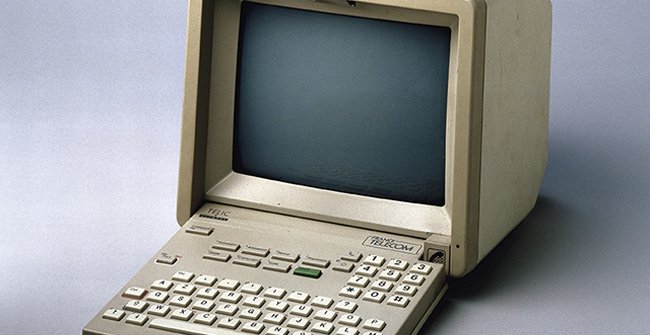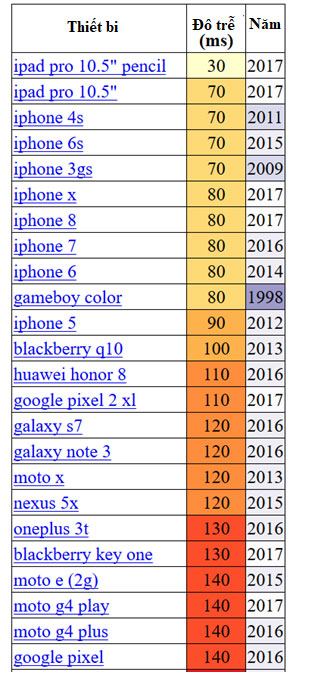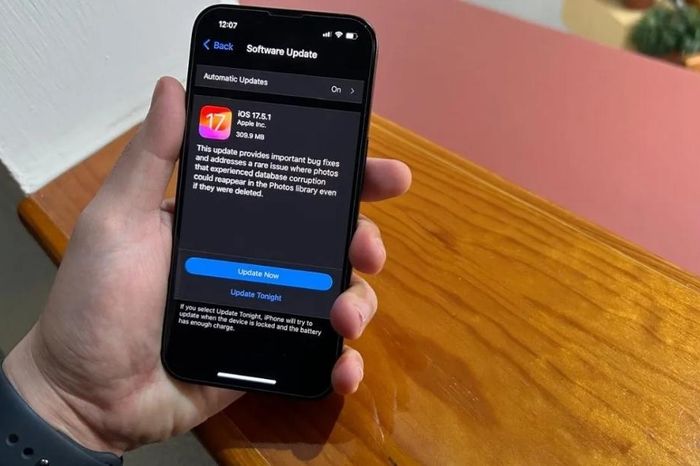Did you know: High-end computers are actually slower than Apple IIe computers released 30 years ago
In the technology world, new products are always introduced with superior strength compared to the old generations in terms of clock, multiplier, number of streams . But in a special parameter, our modern computer It is actually slower than the previous generation computer, which is the speed of computer interaction with commands from humans.
Dan Luu, a former computer engineer who worked at Google and Microsoft, said he felt the new devices didn't run as smoothly as the previous products. He tested a series of desktop devices launched in 1977 to recent computers and tablets.

The results show that modern computers have superior computing capabilities than before. For example: Apple IIe with MOS 6502 processor can implement 0.43 MIPS (million instructions per second - every second), Intel i7-7700k can implement 27,000 MIPS.
But in terms of computer response to human interaction, Apple IIe was born more than 30 years ago and is faster than any modern computer.
Luu used two cameras, one with a speed of 240 frames per second, the other one was 1000 frames per second to measure the computer's response time, from pressing a character on the keyboard until it appeared. on the terminal window. The results show that for 1 character to go to the screen, Apple IIe takes 30ms while PowerSpec g405 with the new Intel i7 processor takes 200ms.

Luu's test results on different computers.
From his testing, Luu discovered that the operating system and the scanning frequency (refresh rate) of the monitor significantly affected the speed of the computer's response.
For example, the frequency of scanning and displaying characters on the 24Hz screen Haswell-e processor takes 140ms, while on the 165Hz screen is 50ms.
With the operating system, new versions need to take multiple steps to enter a character. For example, with iOS, when pressing a character on the iPad, it needs to go through 11 steps.
Not only in iOS, all operating systems must support a wide range of devices. This makes Android devices Luu tested slower than iOS, and operating systems like Windows or MacOS X later on the same computer compared to Chrome OS, MacOS 9.

Detailed results of Luu's test on mobile devices.
But the latency of modern computers is not a terrible thing, it's a trade-off. Our computers now do more work than a computer 30 years ago even though they have higher latency.
See more:
- Which screen parameters are completely meaningless?
- Top 8 best battery laptops in 2017 according to the evaluation of Cnet page
- Don't think 4K is terrible, with these technologies, that's still not enough
You should read it
- How to Speed Up Your Computer
- 3 ways to speed up computers running slow like 'crawling turtles'
- To speed up the Windows 7 boot process, read this article
- Instructions on how to upgrade RAM on computers and Laptops
- How to speed up computer effectively - Speed up computers, laptops
- Speed up your computer to make your computer run faster
- Speed up your computer - 12 steps to have a computer that always looks like new
- Which upgrade will improve your computer's performance the most?
May be interested
- What's remarkable in the new macOS version 10.13 High Sierra?
 along with ios 11, macos 10.13 high sierra is the operating system that will be officially released by apple in 2017. so what are the changes and upgrade features on this operating system?
along with ios 11, macos 10.13 high sierra is the operating system that will be officially released by apple in 2017. so what are the changes and upgrade features on this operating system? - Apple celebrates 3 years of losing Steve Jobs like?
 the late ceo steve jobs of apple left on october 5, 2011 three years ago, because of pancreatic cancer. he passed away when he was 56 years old.
the late ceo steve jobs of apple left on october 5, 2011 three years ago, because of pancreatic cancer. he passed away when he was 56 years old. - iOS 16 currently runs on 90% of iPhones released in the last four years
 apple has just officially updated ios 16 and ipados 16 device usage data on its developer website.
apple has just officially updated ios 16 and ipados 16 device usage data on its developer website. - Mac computers - Interesting changes
 apple computer users have been accustomed to the presence of nvidia geforce graphics platform for years. however, the latest moves from manufacturers show that this will change next year, despite many skeptical comments from the community.
apple computer users have been accustomed to the presence of nvidia geforce graphics platform for years. however, the latest moves from manufacturers show that this will change next year, despite many skeptical comments from the community. - Apple fixes iPhone and iPad bug that restores old photos deleted years ago
 apple has released a new update for iphone and ipad to address a strange bug that caused old photos in the photos app that were deleted years ago to return.
apple has released a new update for iphone and ipad to address a strange bug that caused old photos in the photos app that were deleted years ago to return. - History of computer development
 computers are a tool to help people quickly solve math problems that need high computational skills and have gone through many technological advances, from large computers that occupy the entire room to the present. hands and can carry easily.
computers are a tool to help people quickly solve math problems that need high computational skills and have gone through many technological advances, from large computers that occupy the entire room to the present. hands and can carry easily. - Apple is about to launch a high-end modular module that will cost a lot
 this continues to be a product line that is expected to bring high profits to apple.
this continues to be a product line that is expected to bring high profits to apple. - The first model of Apple phones still works even after 26 years old
 sonny dickso, an australian's youtube account recently posted a complete apple walt 1993 prototype. this is a large screen phone, supporting a stylus, which was revealed by apple 26 years ago.
sonny dickso, an australian's youtube account recently posted a complete apple walt 1993 prototype. this is a large screen phone, supporting a stylus, which was revealed by apple 26 years ago. - How to Experience Apple Music on Windows PC
 the web-based version of apple music on computers was launched to users 2 years ago, allowing us to experience our favorite music space right on the browser without having to install itunes.
the web-based version of apple music on computers was launched to users 2 years ago, allowing us to experience our favorite music space right on the browser without having to install itunes. - Apple's premium headphones will be called 'AirPods Studio', the over-ear design will cost $ 349
 apple's high-end headphones will be released sometime later this year.
apple's high-end headphones will be released sometime later this year.










 Microsoft test video proves that Edge browser is superior to Firefox and Chrome
Microsoft test video proves that Edge browser is superior to Firefox and Chrome Vietnamese digital knowledge system - itrithuc.vn: Wikipedia social network for Vietnamese people officially operates
Vietnamese digital knowledge system - itrithuc.vn: Wikipedia social network for Vietnamese people officially operates Warning: 250 Android games overhear your TV program to show ads
Warning: 250 Android games overhear your TV program to show ads The insurance center in Vietnam confirmed that the users of the old iPhone will be replaced with the battery for $ 29
The insurance center in Vietnam confirmed that the users of the old iPhone will be replaced with the battery for $ 29 Experience using itrithuc.vn - the first digitized Vietnamese knowledge system project
Experience using itrithuc.vn - the first digitized Vietnamese knowledge system project How to check the original purchase date of the iPhone / iPad on Apple's website
How to check the original purchase date of the iPhone / iPad on Apple's website